Menu
close
The red buckeye is among the most beautiful eastern North American tree species, especially in flower, when the brilliant red panicles glow in the woodsy understory. The species occurs naturally in pinela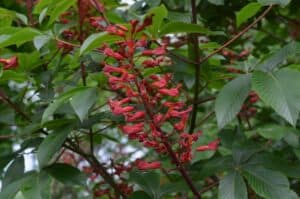 nds, pine-deciduous woods, wooded bluffs, stream banks and bottomlands throughout the range. The USDA Plants Database shows distribution in the wild from North Carolina to Florida west in an arc to West Virginia Kentucky, southern Illinois, southeast Missouri dipping into Texas. I observed numerous plants along coastal South Carolina and Mobile Bay, Alabama, growing in sandy soils. Based on the southern distribution, one could assume lack of hardiness, yet plants in gardens and arboreta survived -20°F and below. Spring Grove Arboretum, Cincinnati, OH, has many beautiful specimens that have experienced below -20°F through the years. The species is successful at the Morton Arboretum, Lisle, IL, which in the 2018-19 winter recorded -24°F. The Minnesota Landscape Arboretum, Chanhassen, MN, grows ‘Atrosanquinea’, a bright red-flowered cultivar.
nds, pine-deciduous woods, wooded bluffs, stream banks and bottomlands throughout the range. The USDA Plants Database shows distribution in the wild from North Carolina to Florida west in an arc to West Virginia Kentucky, southern Illinois, southeast Missouri dipping into Texas. I observed numerous plants along coastal South Carolina and Mobile Bay, Alabama, growing in sandy soils. Based on the southern distribution, one could assume lack of hardiness, yet plants in gardens and arboreta survived -20°F and below. Spring Grove Arboretum, Cincinnati, OH, has many beautiful specimens that have experienced below -20°F through the years. The species is successful at the Morton Arboretum, Lisle, IL, which in the 2018-19 winter recorded -24°F. The Minnesota Landscape Arboretum, Chanhassen, MN, grows ‘Atrosanquinea’, a bright red-flowered cultivar.
The species is utilized as an understory plant in the Dirr garden, residing in the towering canopy of white oak, tupelo, and sweetgum. In this shade environment, trees are smaller and more open. Flowering is moderated a degree but still respectable. The habits of open-grown trees vary from oval-rounded to rounded, usually clothed with dense branches and large compound palmate leaves. Landscape size ranges from 15 to 25’ in height with similar spread. The National Champion (2019) was 48’ high and 37’ wide and resided in St. Louis, MO. I was asked many years past how I determined tree sizes in the Manual of Woody Landscape Plants. I typically reduced champion sizes by 50%. Not a bad rule of thumb for landscape sizes.
The foliage is beautiful, especially the early emerging leaves in riotous colors of green, purple-green, purple, yellow, orange, red, bronze and other permutations (see photo). The effect is ephemeral for the foliage soon becomes shiny dark green. Fall color is yellow at best, assuming there are persistent leaves. The anthracnose/blotch often defoliates trees by late summer. Each leaf is composed of 5 to 7, doubly serrate leaflets, to 6” long.
Flowers, pure red in the best incarnation, open with the emerging foliage in late April (Athens). They remain effective for two weeks or longer, depending on temperatures. The individual tubular flowers, 11/2 to 2’” long, are borne in a 6 to 8” long panicles at the ends of the shoots. Flowers are pollinated by the ruby-throated hummingbirds. A tree in resplendent flower is the tonic of spring. Red buckeye hybridizes with A. flava, A. glabra, and A. sylvatica, the result a mixed bag of flower colors.
The fruit is a large, smooth-skinned dehiscent capsule with one/two shiny rich brown seeds. As soon as the capsule starts to split, they should be collected and the seeds removed. Plant immediately as seeds will quickly wither. I sow seeds in 3-gallon containers filled with pine bark, cover with one-inch of bark, protect from predators, and leave outside. The root radical emerges soon after planting; the shoot the following spring. The seedlings are divided in late fall, tap root pruned, and transplanted to 3-gallon containers. The seedlings often flower in the second or third year.
Certainly, an adaptable species and can be grown in acid or high pH, sandy to clay-based soils with moderate moisture. Does show drought stress and requires supplemental water. The worse-case scenario is the leaves abscise but the tree bounces back the next year. I wish the species were more available in garden center commerce.
Aesculus pavia and A. hippocastanum hybridized in cultivation, largely without the hand of the breeder, to produce A. ×carnea, the red horsechestnut, and the cultivars ‘Briotii with deeper red flowers, ‘Fort McNair’ with lighter pink flowers and greater leaf blotch resistance, and ‘O’Neil’s Red’ with close to red flowers. ‘Briotii’ is one of Bonnie’s favorite flowering trees, consistently flowering in the garden since planting in 2013.
I have always loved the buckeyes and horsechestnuts and perhaps this small essay with inspire others to engage with the genus.
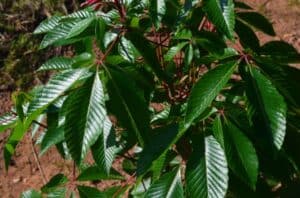
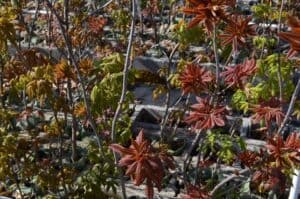
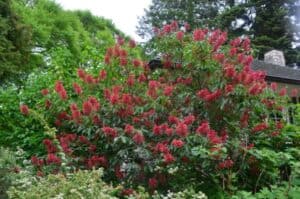
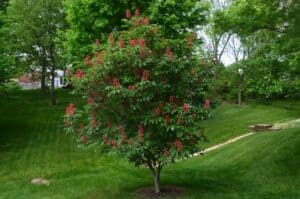
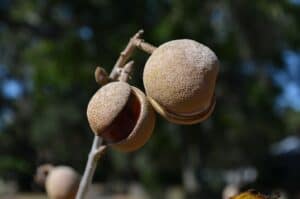
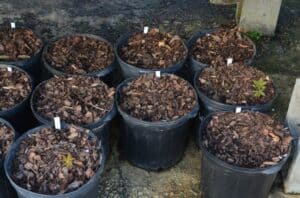
Chionanthus retusus- Chinese fringetree
Michael A. Dirr
In 2018, I was asked to assist with our county’s (Oconee, Georgia) tree planting project for a new four-lane, 3.5-mile highway. The county commissioner emphasized the concept of a tree-lined gateway to the county seat, Watkinsville. After many meetings, nursery visits and suggestions, we agreed upon 760 trees, comprising 51 different species and cultivars. The landscape architect sited the trees to minimize underwire issues, sight-line intrusion, and space allocations (medians). Locating diverse small tree species, 15 to 30’, was difficult and redbuds and dogwoods were overplanted, with more loses than I expected. One superlative addition was Chionanthus retusus, Chinese fringetree, the only regret, we did not use more. Chionanthus viriginicus, the native white fringetree, was presented in a previous HMI article/blog. It was included in the project and has prospered.
There are 60 Chionanthus species widely distributed in the tropics with only the above two species temperate zone cold hardy. Chionanthus retusus occurs in mixed forests, thickets, and along rivers in China, Korea, and possibly Japan. In cultivation, it forms a broad-rounded to spreading outline, often with long splaying shoots. I observed permutations in habit from vase-shaped to columnar (‘Tokyo Tower’). I estimate the species landscape size between 15 to 25’ high and wide. The bark on young trees is exfoliating/curling; with age and size, ridged and furrowed, the ridges flat and gray, the furrows, deep brown to black.
Foliage is 2 to 3” long, rounded in outline on ‘China Snow’; 6 to 8” long and narrow elliptic on ‘Arnold’s Pride’. Typically, deep green to glossy dark green in summer and tremendously heat and drought tolerant. Fall color, soft yellow to golden yellow, develops late (November-December), remaining effective for many weeks. The foliage is freeze resistant to at least 25°F.
The flowers are borne in 2 to 3” high, 2 to 4” wide panicles, mid to late May, Athens (zone 8). The flowers occur at the end of the new season’s shoots and shroud the canopy in a fleecy dome of snow; effective for several weeks depending on temperatures. The sexes are separate (for most part), thus fruits may or may not be present. The fruit is a dark blue, ½” long ovoid drupe, the outer covering fleshy, the inner a stone-like seed. Fruits ripen in September-October and persist longer than those of C. virginicus. Birds have stripped C. virginicus on campus while fruits of C. retusus persisted into late fall.
The species is well adapted to extremes of soil, except wet. Acid, alkaline, clay-based, and droughty (once established) are fair game. For maximum flower effect, site in full sun, yet plants in shade are effective. The species transplants readily and is available container-grown and balled and burlapped. Hardiness is open to question with zones 6 to 8 (9) suitable. I suggest -15°F will seriously injure plants, although a 30 to 35’ high specimen, grown from seed collected by E. H. Wilson, has been growing for over 100-years in Boston’s Arnold Arboretum.
The species has thrived in the highway setting and has generated questions about identity. It is an excellent under wire tree and with new cultivars available serves as an alternative to time-honored redbuds and dogwoods.
Cultivars:
‘Arnold’s Pride’ is mentioned above. Vase-shaped outline with longer/clearer trunk and suitable for street tree use. Now in commerce and available from Pleasant Run Nursery, New Jersey.
‘China Snow’ is the thick-textured, glossy dark green leaf, profuse flowered selection developing a rounded outline with a low-branched trunk. Fits the 15 to 25’ high and wide size category. Named by don Shadow, Winchester, TN. Reasonably common in commerce.
‘Tokyo Tower’ is a more or less columnar form, slightly wider at the top, creating a narrow vase-shape silhouette. The 11-year-old plant in the Dirr garden is 24’ high and 8’ wide. Did not produce many flowers until the 6th year and then primarily in the upper branches. A superb choice where lateral space is limited.
Other cultivars include ‘Ashford’, ‘Confucius, and Spirit® (‘CRN10’).
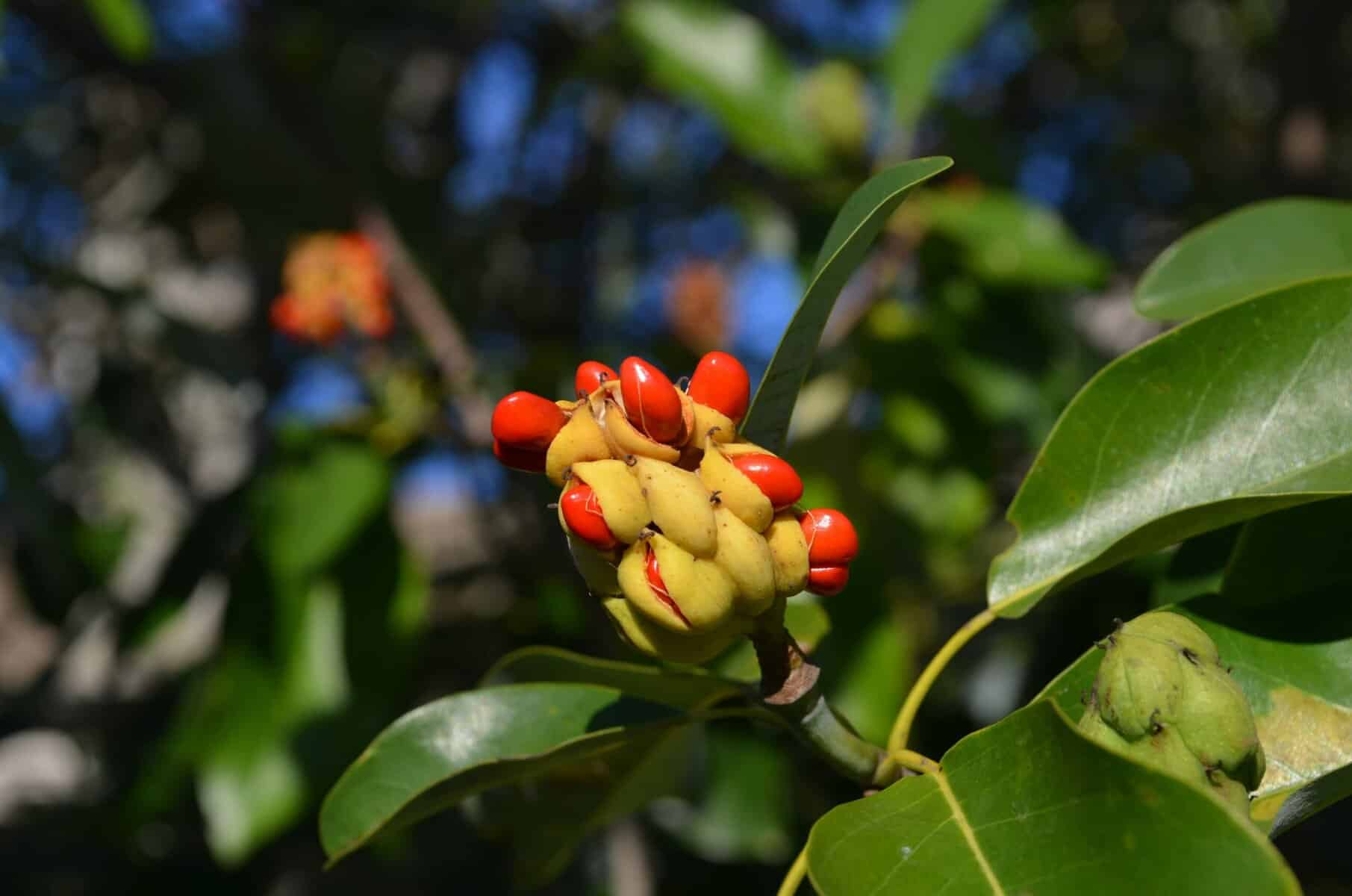
In previous tree profiles, I discussed Magnolia acuminata and M. × soulangeana and herein highlight an increasingly important landscape species, M. viginiana. It is becoming more common in contemporary landscapes because of new cultivars with smaller sizes, increased cold hardiness, and fully evergreen foliage into zone 6 landscapes. The impetus for this discussion resulted from the August 5, 2020 visit to Apalache Nursery, Turtletown, TN. The owner, Keith Kilpatrick and his son, Taylor, have been long-time friends and native tree aficionados. The nursery nestles in a beautiful, unspoiled Brigadoon-type valley with visitors only allowed every hundred years (It was the 100th year anniversary). Bonnie commented the setting was one of the most pristine places she had ever experienced (photo). Keith and son specialize in trees and shrubs grown from wild-collected local seed. Magnolia virginiana ‘Apalache’ is their cold hardy evergreen selection, leaves lustrous dark green, clothed with branches to the ground, 20 to 25’ high. The remarkable aspect of the cultivar is the consistency of habit and foliage when grown from seed (photo, ‘Apalache’). I have grown many seedlings of the species with nothing akin to the parent. In fact, a recent seedling population derived from Keltyk® yielded small- compact and loose-open habits; tiny leaves to semi- tropical foliage (photo).
Magnolia virginiana grows in moist to wet soils, often in swamps, from Massachusetts to Florida, west to Texas, and inland to Tennessee, Oklahoma and Arkansas. In Weeks Bay Wildlife National Estuarine Research Reserve, AL, trees with trunks as large as oaks grew in the swamp next to M. grandiflora and Q. michauxii.
Landscape size is in the 30 to 50’ height range; less in width. National Champion is 115’ high and 66’ wide and resides in Jefferson, FL. Trees are single to multiple trunked, gracefully pyramidal-oval in youth, broad-oval at maturity. The foliage, bright to shiny dark green, the undersides silver-white, provide refined and billowy auras, especially when buffeted by the wind. Leaves range from 3 to 8” long, one-third to one half this in width. The deciduous types may develop pretty yellow fall color. Young stems are light green and when bruised/scraped emit a sweet lemon fragrance. Bark on large trunks is smooth, gray, and similar to beech bark.
Flowers appear in April in zone 8; a tree at the Coastal Maine Botanical Garden, Boothbay, ME, is flowering in October. Flowers develop on old and new growth of the season for several months. Each glistening white, 2 to 3” (4”) diameter, exceedingly fragrant, composed of 9 to 12 tepals (petals and sepals similar in shape and size). The knobby 2” long and wide fruits turn dark red, the red seeds emerging from the follicles on a slender silver thread. Seeds can be collected at this stage, soaked in water, the pulp removed, placed in moist medium in plastic bags, and cold stratified for 2 to 3 months. Seeds often germinate during the cold period; the white root radicles evident. Remove and transplant to suitable germination media.
The species, although native to swamps, will tolerate drier soils, especially once established. I observed chlorosis on plants in the Midwest. A pH range of 5.5 to, shouldering on 7, is suitable. Trees are produced in containers and balled and burlapped. Growth is fast, especially young seedling trees, which easily reach 6’ and more in a season. As a single specimen it develops into a pretty tree. Useful as a patio or large container element. I noticed groupings and rows of trees for screening. On the Georgia campus it has been used to shadow and soften blank-walled buildings. During nursery visits, increased production is evident as the landscape architecture profession has embraced the species for multiple uses.
Most exciting is the number of cultivars introduced in the 21st century. I have grown/observed the following.
Emerald Tower® (‘JN8’) is upright, more compact, with glossy green foliage. 20’ by 8’. Ray Jackson introduction, Tennessee.
Green Mile™ (‘MVHH’) develops a graceful pyramidal habit with long narrow shiny dark green semi-evergreen to evergreen foliage. Size 35’ by 15’. Selected by Alex Neubauer, Hidden Hollow Nursery, TN.
‘Green Shadow’ was fully evergreen after exposure to -20°F. Named by Don Shadow, Winchester, TN. 30 to 40’ high to 20’ wide.
‘Henry Hicks’ is one of the earliest hardy evergreen selections. I have grown it in the Georgia garden and although evergreen, it has been a slow mover. Estimate 30 to 40’ high; 20 to 30’ wide.
Keltyk® ( ‘MVMTF’) has smaller foliage, more compact habit and is completely evergreen, 20 to 30’ high, less in spread. I love this selection. More refined in foliage and habit. Introduced by Moon Tree Farm, GA.
Moonglow® (‘Jim Wilson’) is a larger, loose-growing selection with dark green, semi-evergreen foliage. Matures at 35 to 40’ by 15 to 18’. Survived -28°F without injury. Beautiful plant and widely available in commerce.
‘Northern Belle’ sports darker green leaves then Moonglow® and survived -35°F. 25’ high by 8 to 10’ wide.
‘Santa Rosa’ has the largest evergreen leaves of any cultivar. Selected from a Florida seed source so best in zones (6)7 to 9. More wide spreading than others. 25’ by 20’.
Dr. Dirr's thoughts on the Eastern Arborvitae:
Not quite sure why I never fully respected this soft-textured needle evergreen but an epiphany occurred during a seven-day circuitous, whirlwind-like, 2018 tour of Vermont. From Brattleboro to Burlington, in cultivation and the wild, the species was ubiquitous. Screening evergreens are few in this cold climate state, with arborvitae and hemlock the mainstays. This comment applies to all of New England and the Midwest with arborvitaes extending into zone 8 landscapes. Abundant in the wild, the eye opener was the size, trees commonly 60’ high, varying in width from narrow to wide-spreading.
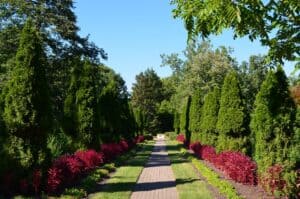
Deer damage in Miami
I noticed salt injury, cold (yes, on some cultivars), deer browsing and what appeared to be leaf miner damage. In cemeteries throughout, it was common to witness ~100-year-old trees. A reference cited a plant being over 1,100 years old. The National Champion is 113’ high and 42’ wide and located in Leelanau, MI. Arborvitae translates to the tree-of-life, thus perhaps the rationale for planting with loved ones. The other (real?) reason for the name was the use of the foliage to supply vitamin C to combat scurvy for French explorer Jacques Cartier’s men during the 1535-36 winter.
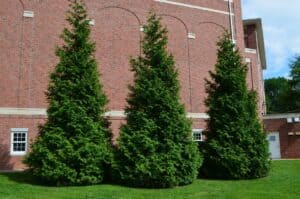
The species displays remarkable climatic and soil adaptabilities which are the foundations for its landscape ubiquity. I observed it in landscapes and/or the wild from Maine to Minnesota, south to Georgia. A native population in the Natural Bridge Park, south of Lexington, VA is the most southern native outpost I observed although it crosses over to a few counties in eastern Tennessee.
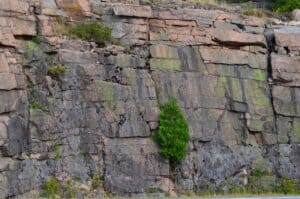
Cedar Creek produced the deep limestone gorge, some 215’ deep, providing cooler temperatures. One old trunk was about 2/3’ in diameter. Seedlings and 20-30’ high trees were present on the slopes and flood plains indicating the species is still regenerating in the area. My initial thought was focused on whether the southeast provenance would be more heat-tolerant. In Vermont and Maine, trees grow from rock fissures/crevices, in bogs and around swamps, typically in sun, but as with the Natural Bridge plants, also in partial shade.
Growth habits are remarkably diverse…tall, slender, columnar, pyramidal to broad-oval, single- or multiple-trunked and often low branched. I pin-pointed landscape size in the 30 to 40’ range but need to recalibrate after Vermont. A great attribute of T. occidentalis is its ability to withstand interminable pruning. Some hedges are at a perpetual standstill.
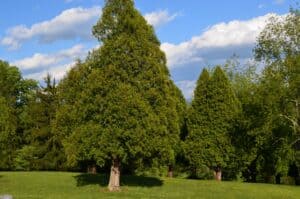 Foliage (needles) are 1/12” long and flattened to the stem, like shingles on the roof, soft to the touch, bright green in summer, often yellow-green to bronze in winter. Cultivars ‘Nigra’, ‘Techny’, ‘Technito’, and others are greener in winter.
Foliage (needles) are 1/12” long and flattened to the stem, like shingles on the roof, soft to the touch, bright green in summer, often yellow-green to bronze in winter. Cultivars ‘Nigra’, ‘Techny’, ‘Technito’, and others are greener in winter.
The species is monoecious, male cones small, reddish; female 8 to 10 scaled, green then rich brown at maturity, ripening in fall and persisting through winter. Seeds require a brief cold-moist stratification period. Cuttings root readily, especially after exposure to cold in fall. Bark is light gray-brown, with shallow fissures, developing fibrous threads. Wood is light, durable, rot resistant and used for furniture, especially the famous Adirondack chairs.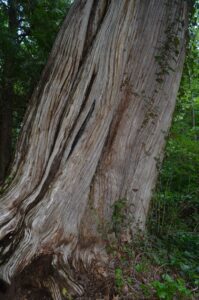
The species spawned numerous cultivars with dark green, blue-green, yellow, variegated, twisted, stringy foliage; dwarf, columnar, weeping habits. There is an eastern arborvitae selection for every landscape niche. In practice, the hedging/screening/cold hardy types are most in demand. In Oregon, I noticed fields of nothing but ‘Emerald’ (‘Smaragd’) most of which will be utilized in midwestern and eastern gardens but, in recent years, becoming more common in the southeast.
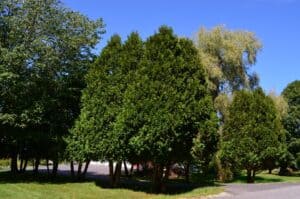
There is more to the Thuja story with ‘Green Giant’, a hybrid of T. plicata and T. standishii, offering deer resistance, more lustrous dark green foliage, and soft-textured pyramidal habit. To date, it has displayed high heat tolerance and become a favorite of the southeastern nursery industry. Thuja standishii, Japanese arborvitae, is a graceful species, not well known, with habit and architecture similar to Cupressus nootkatensis (formerly Chamaecyparis nootkatensis). The few specimens I observed (Missouri Botanical Garden, Virginia Tech, Hampton Roads, VA, and New Haven, CT), offer promise for selection and breeding.
Without equivocation, the American elm was the dominant street, shade and urban tree species in North America until the introduction of Dutch elm disease. Embedded in its genome (DNA) is the ability to prosper in wet, dry, acid, alkaline, cold and hot environments. Fast growing, easy to transplant, and guaranteed to survive the salvos of urbanization, that is, until a small beetle (several species carry the fungus) and fungus humbled this iconic treasure. I am frequently asked whether it makes sense to plant the American elm. My response is, certainly, but utilize one or more of the DED-resistant cultivars (discussed later).
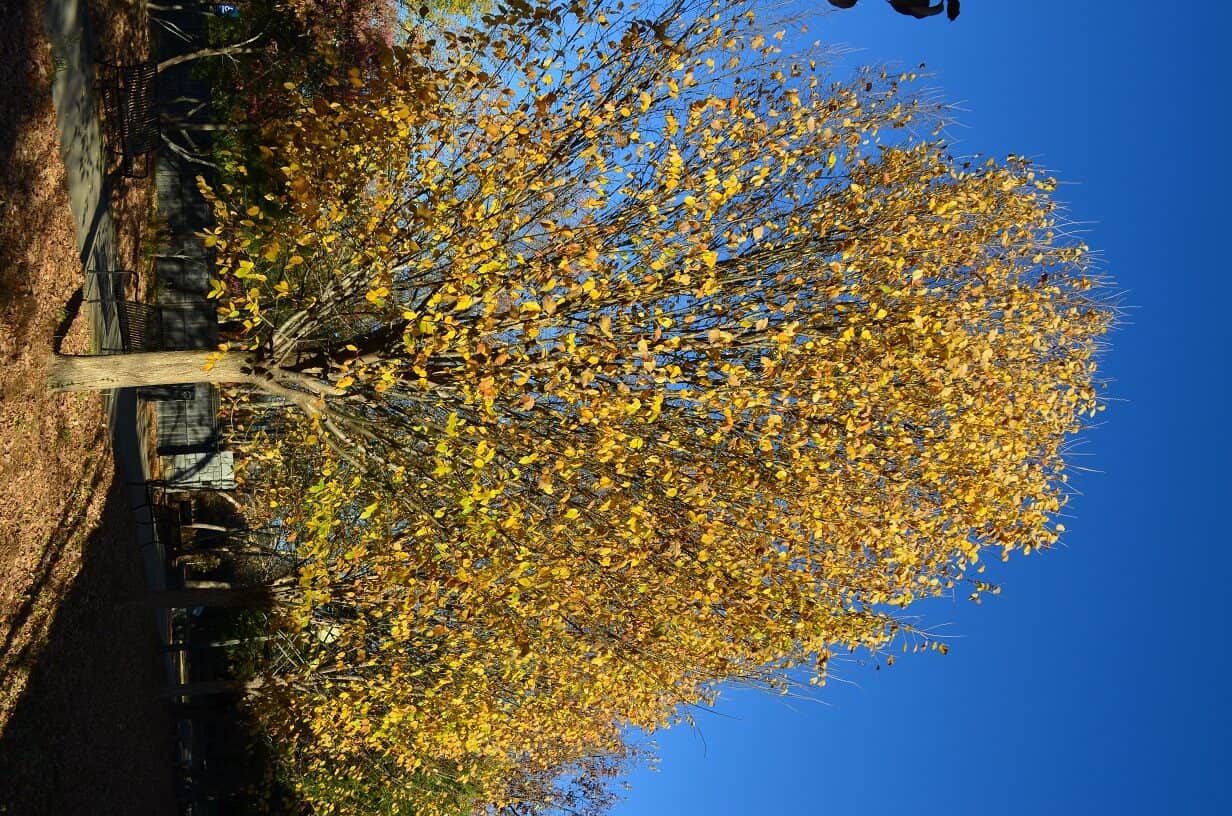
Ulmus americana Princeton
When calamity confronts America in any form, we often discover/invent other strategies to overcome the challenges, in this situation, the disease. Elm breeding and improvement programs at the University of Wisconsin, University of Georgia, Morton Arboretum, Kansas State University, U. S. National Arboretum/USDA and others resulted in a plethora of resistant introductions. The search for resistant genes opened the floodgates to exploration and the introduction of new germplasm. Approximately 18 elm species are distributed from North America, Mexico, Europe, north Africa to Asia. These species offer degrees of resistance to DED and other maladies with Ulmus parvifolia, U. pumila, U. japonica, and U. nikoense among the most resistant.
An encouraging observation as I travel America is the increased planting of American elm, from Minnesota to Georgia, and throughout New England, the latter where ancient noble specimens still reside. As a graduate student at the University of Massachusetts from 1969 to 1972, I watched the demise of the American elm on campus. I am still involved with the University, visit often, walk campus and the town of Amherst. Scattered throughout the town are beautiful remnant trees that survived the disease invasion. On campus proper, a Japanese elm, Ulmus japonica, planted in 1890 is extant and thriving (largest in the US), and bears testimony to the resistance lacking in many American elms.
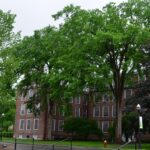
Ulmus americana Dartmouth, NH
The iconic vase-shaped habit, the outer branches gracefully arching, combine to form the picture-perfect shade tree. Zelkova serrata, Celtis occidentalis, Celtis laevigata, were considered alternatives but I have yet to experience any resembling the best American elm. Zelkova serrata and cultivars were highly touted and planted (still being planted) but seldom impress. I have yet to observe any 70-80’ high Zelkova serrata.
The disease-resistant cultivars discussed herein offer hope for the partial return of the species and should be the first options. Many years past, I was working at Wofford college in Spartanburg, SC. Our group was debating tree species for median plantings. I suggested ‘Princeton’ American elm for the entire project (two different streets). Others wanted Zelkova serrata, so one street was planted with ‘Princeton’; the other Zelkova. Today, as I view the trees, ‘Princeton’ is the most aesthetic and successful (see photo).
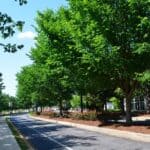
Ulmus americana Princeton Wofford
The following descriptions are derived and expanded from the new tree book by Keith Warren and me. Keith worked for Schmidt Nursery, Boring, OR for 40 years and has hands-on experience with all selections mentioned below. All are large trees with estimated mature size at 70’, except for Prairie Expedition®. Tested for DED means the selection survived the controlled inoculation of the fungus.
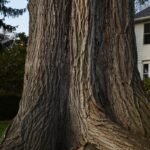
Ulmus americana bark
‘American Liberty’ is a multiclonal series of six introductions with varying degrees of DED resistance. Keith mentioned they are not up to the standards set by the newer cultivars. A clone, ‘Independence’, is probably the best.
Colonial Spirit™ (‘JFS-Prince II’) forms the classic vase-shape. Keith considers this one of the best for form. Tested for DED. Found in New Jersey.
Creole Queen™ (‘UASNZ’) was discovered near New Orleans. Similar to ‘Princeton’ as a young nursery tree. Not DED tested. I see both trees in a local Georgia nursery and have a difficult time telling them apart.
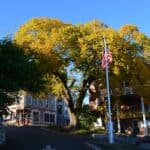
Ulmus americana Castine Maine
‘Princeton’ was selected in 1922 and is the most widely planted cultivar. An old specimen at the Arnold Arboretum embodied the graceful form of the species. As a young nursery tree, the branches are so tightly borne, it has the appearance of an inverted corn broom. With age, it opens to the classic form. DED tested and resistant. Occasional infected trees have been found.
‘Washington’ was released by the National Park Service (NPS) but is probably no longer available. Disease tolerant to some degree.
‘Jefferson’ was selected from the Washington Mall by the NPS. I observed the original tree. Not as elegant as the others. Good resistance.
‘New Harmony’ forms a broad oval in youth, eventually broadly vase-shaped, limbs terminating in numerous, slender often drooping branches. 68’ by 72’ at maturity (introducer’s size). U. S. National Arboretum release in 1995. Considered zone 5 to 10 per USNA and less cold hardy then many.
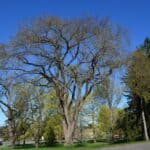 Prairie Expedition® (‘Lewis and Clark’) is a North Dakota State University release with a lower, wide spreading outline. Pretty dark green foliage. Tested for DED. Cold hardiness to zone 3, possibly 2.
Prairie Expedition® (‘Lewis and Clark’) is a North Dakota State University release with a lower, wide spreading outline. Pretty dark green foliage. Tested for DED. Cold hardiness to zone 3, possibly 2.
St. Croix™ (pp 20097) from Minnesota is a broad vase-shaped selection. The original tree was 75’ high, 110’ wide. Tested for DED. Zone 3.
‘Valley Forge’ is a sister introduction to ‘New Harmony’. Extremely fast growing and requires pruning to shape. Was 26’ high and 30’ wide at 12 years old. Has the best DED resistance of all the cultivars herein. Introduced in 1995. Zone (4)5 to 9.
The majority of the resistant selections are “survivor seedlings” that persisted after DED swept North America. ‘Valley Forge’ and ‘New Harmony’ were bred, tested for DED and selected after 20 years of research by USNA. As mentioned, I encounter many trees of like constitution across the country that have never been tested but have survived and prospered. Opportunities exist for new and possibly improved introductions. The next great American elm is out there!
The North American deciduous forest is rich with oak diversity such as Quercus bicolor. Oaks are categorized as belonging to the White or Red /Black groups. The former with rounded lobes or teeth (no bristles), acorns ripening the first year, often scaly bark; the Reds with bristle-tipped leaf lobes, acorns ripening in two years, and pebbled to ridged and furrowed, non-scaly bark. Hybrids occur within each group but not between. A red oak, Q. rubra, will not cross with a Q. alba.
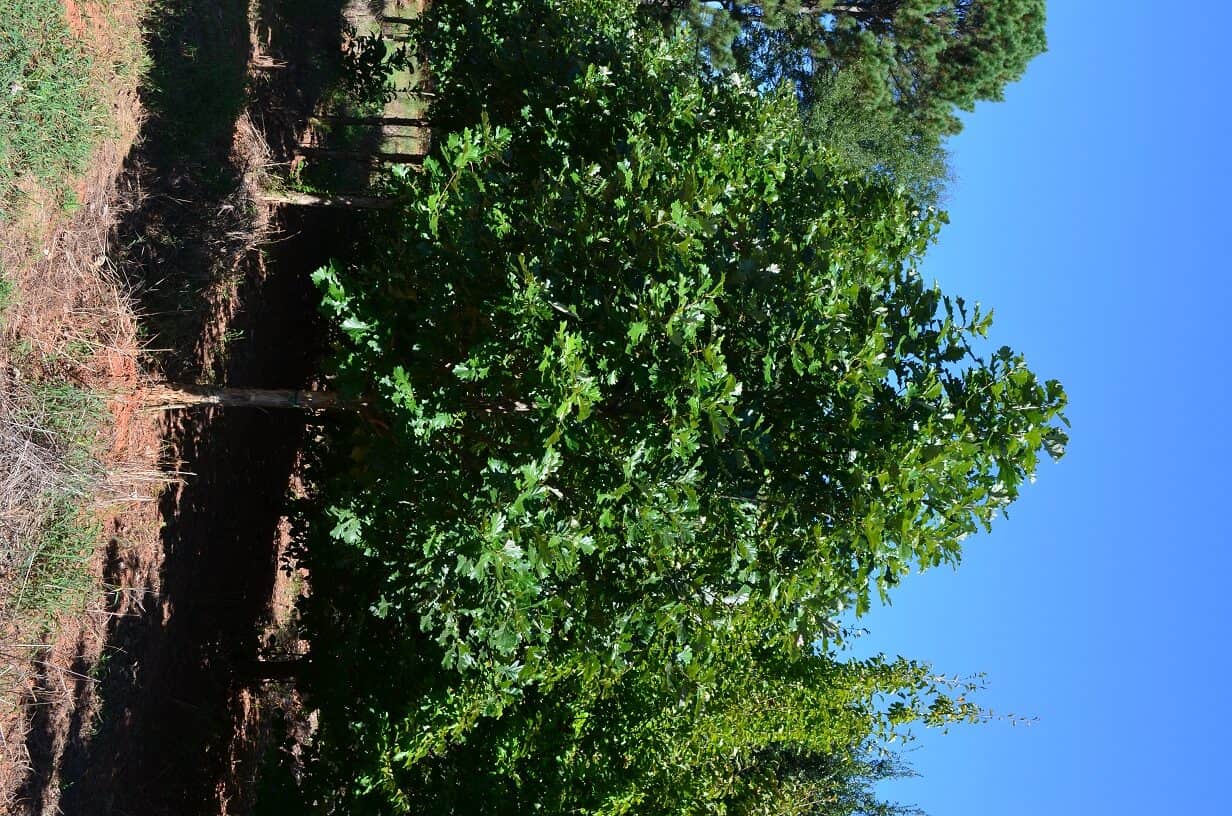
Quercus bicolor American Dream
Oaks are being utilized in greater numbers as new cultivars are introduced. In the past, the majority of nursery grown oaks were seedlings with the inherent variation in growth habit, growth rate, summer foliage, fall color, etc. With advances in cutting propagation and emphasis on grafting and budding, uniform cultivars are commanding greater market share. Select Trees, Athens, GA, produces all its oaks on their own-roots. Mike Glenn, owner, saw the wisdom to this approach 30 years ago and has continued to refine the process to make it economically viable. John Barbour, Bold Spring Nursery, Hawkinsville, GA has embraced the own-root approach and introduced many cultivar oaks with superior traits.
Quercus bicolor Malone Beacon
Quercus bicolor, swamp white oak, is among the most noble of oaks, reaching 80 to 100’ high and wide in the U.S. The species is native from Maine, west to Minnesota, south into South Carolina, Alabama, and Mississippi, usually in moist to wet soilsin flood plains and along river/stream banks. Although absent from Georgia it is grown by many nurseries and is being planted in commercial and residential landscapes. Easier to transplant than the equally beautiful Q. alba and therefore has been commanding greater attention. In Salt Lake City it is planted around the Temple Grounds and there, several trees are close to gold because of the high pH soils. The species is ideally served by an acid soil reaction. The hybrid, Q. x schuettii, Q, bicolor x Q. macrocarpa, offers greater tolerance to high pH soils and is common in the Chicago area and upper Midwest.
Quercus bicolor Beacon
The habit of Q. bicolor is rounded to broad rounded with large muscular secondary branches. The bark is gray to gray-brown and exfoliating on the branches and trunk. Landscape size approximates 50 to 60’ in height, similar or greater width. Several of the most beautiful swamp white oaks were planted in 1930 at Mt. Airy Arboretum, Cincinnati, OH. They are in the 60’ vertical range, much wider in outline and remarkably healthy (2016).
Quercus bicolor spring foilage
Foliage emerges bronze, copper to reddish brown, lustrous dark green in summer, before turning yellow to russet-red in autumn. Leaves are large, to 7” long with 6 to 10 pairs of obtuse teeth; the underside grayish green to whitish tomentose (dense hairs).
The shining light brown acorn is one inch long, covered about a third by the cap (cup), usually paired and borne on a slender, 1 to 4” long stalk. Acorns should be planted as soon collected. There is no dormancy and root radicles emerge in a few weeks. I have raise many seedlings by planting 10 seeds in a three-gallon container, protecting from animals, and leaving them outside.
Quercus bicolor fall color
Several new selections of the species include American Dream® (‘JFS-KW12’) and Beacon™, the former from Schmidt nursery which involved observing over 10,000 seedlings, starting in 1998, selecting 66, then 18 and finally one, introduced in 2012. Uniform pyramidal habit in youth, glistening bronze young leaves, mature lustrous dark green, then yellow in fall. Foliage is resistant to powdery mildew and oak anthracnose, heat and drought resistant. Estimate 50 to 60’ by 40’ at landscape maturity. To my knowledge, this is the first clonal swamp white oak. Bonnie and I planted a tree on the University of Massachusetts (UMASS) campus in memory of our daughter, Suzanne, and one in our Georgia garden. Both trees are thriving.
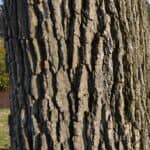
Quercus bicolor bark
Beacon™ (‘Bonnie and Mike’) was a chance discovery in Virginia. Bonnie and I were touring the Shenandoah Valley and came upon this distinctly columnar Querus bicolor in March, 2007. We collected scion wood, sent to Schmidt for budding and evaluation. The foliage is deep lustrous green, yellow in fall. Emerging leaves are beautiful coppery red, aging to yellow-bronze. Estimate mature size as 40 to 50’ high by 10 to 15’ wide. It is an excellent choice for areas where lateral space is restricted. Trees are successfully growing on the UMASS campus and in the Dirr garden.
Frank Schmidt Nursery, Inc. Boring, OR, (www.jfschmidt.com) introduced the trees to commerce, produces and sells liners to finished nurseries across the U.S. and Canada. Both trees are now being produced by many finished growers.
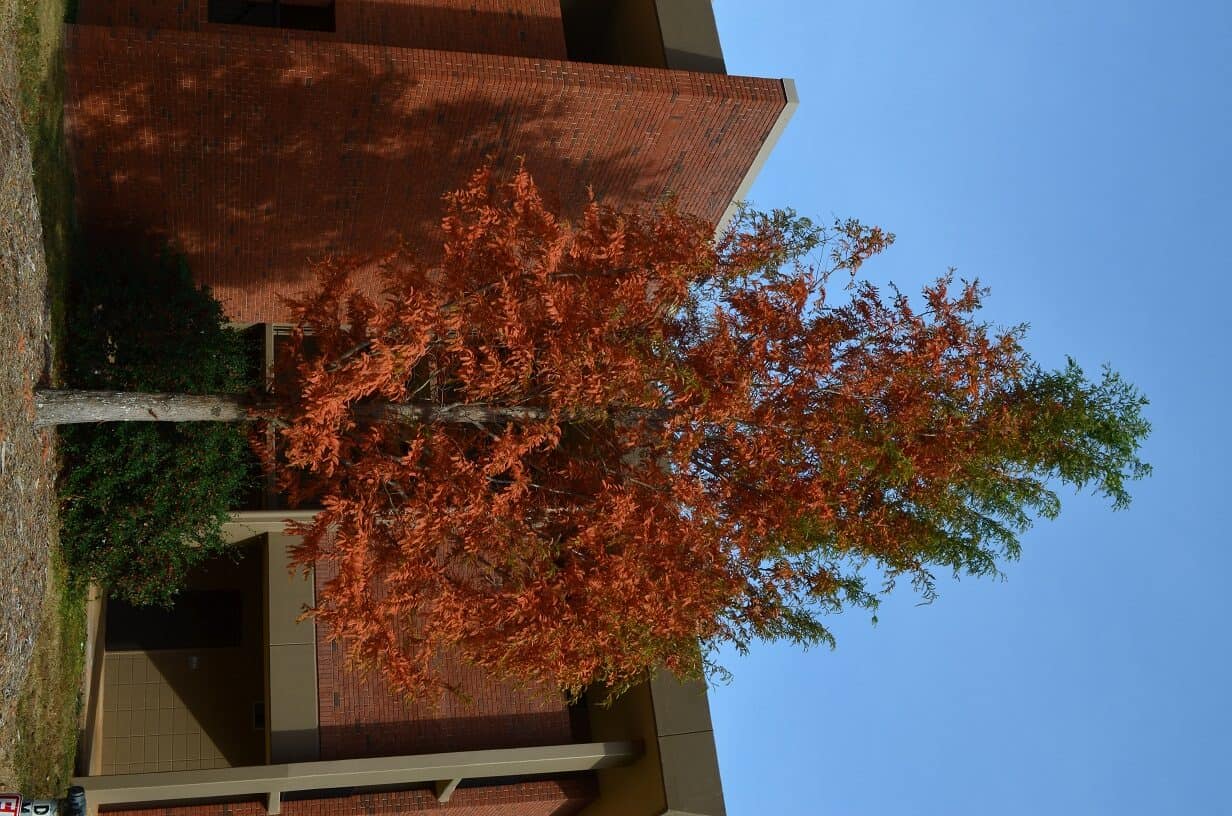 Dr. Dirr's Tree Spotlight
Dr. Dirr's Tree SpotlightThe species, Metasequoia glyptostroboides, was considered extinct until rediscovered in the 1940s in China and reintroduced via the efforts of the Arnold Arboretum, Jamaica Plain, Massachusetts. Seeds and seedlings were distributed to many public gardens and universities with trees now over 100’. Missouri Botanical Garden, St. Louis, houses many of the original seedlings and introduced Shaw’s Legacy™ (‘Peter Raven’, notable because of the denser conical pyramidal habit and darker green needles. This is a large tree, easily 70’ by 30’ at maturity. It was planted in 1952. Considering the narrow gene base (diversity), many unique cultivars have resulted from the original introduction (see cultivars)
Habit is soft, feathery, conical pyramidal, the needles bright green, turning rusty orange to brown in autumn. The needle-bearing branches, oppositely arranged, abscise in toto in fall. The opposite arrangement permits easy separation from Taxodium distichum, common baldcypress, with alternate branches and buds.
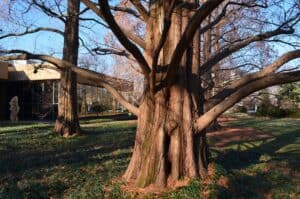
The bark is beautiful, rich reddish brown, slightly shedding in thin strips, the trunk with cavities under each branch attachment. Though deciduous, the unique branching and bark characteristics provide exquisite winter beauty. Tree bark glows rich saturated orange-red in the late afternoon winter sun.
Single specimens, grouping and groves inspire. Excellent tree along streams and in moist soil areas. Extremely tolerant of excess moisture and I observed trees in standing water. Years past, in Boskoop. Netherlands, I observed an entire street planted with Metasequoia. The species is surprisingly well suited to drier soils once established. Growth is fast, easily 2 to 3’ per year, for the first 10 years, if provided reasonable care. Trees are wind-firm and resistant to breakage. I have not observed chlorosis on the species; whereas, T. distichum, develops chlorosis on high ph soils. Hardness is listed at zone 5 to 8, which is reasonably accurate. I noted branch dieback on a tree at the University of Maine, Orono (zone 4).
If there is an Achilles heel to use in contemporary landscapes, it would center on size. However, this is a great asset for parks, campuses, golf courses, and commercial grounds. New, smaller statured cultivars are available which counters the size argument.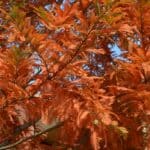
The cones are similar to Sequoia sempervirens, ovoid, egg-shaped, ¾ to 11/4” long, with 14 to 28 scales, maturing in autumn and opening to shed the small, light brown, winged seeds. I have collected cones as they open, harvested seeds, stratified for 30 days, with excellent germination. Seedlings will grow 6’ high in a 3-gallon container in a single season (zone 8). Cuttings can also be rooted to perpetuate desirable traits.
Cultivars of some note which are available in commerce are listed below. This is not an exhaustive list.
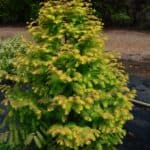
Amber Glow
Amberglow™ (Wah-08AG’) is a seedling of ‘Ogon’ with orangish yellow emerging needles, maturing yellow. The habit is dense, compact with estimated size, 15’ by 7 to 8’. I am impressed with the needle color and smaller stature, making it a realistic choice for contemporary gardens.
Jade Prince™ (‘JFS-PN3Legacy’) has cleaner, brighter green foliage than the species. Habit is quite dense in youth, upright-pyramidal in habit, fast growing and shapes up cleanly in the nursery; 70 to 80’ high, 20 to 25’ wide.
‘Jack Frost’, ‘Snow Flurry’, ‘White Spot’, and ‘White Tips’ offer green foliage marked/streaked to various degrees with white. Color is lost as needles mature. Pretty when first emerging. Have only observed small trees but estimates to 60’ high and 20’ wide are given.
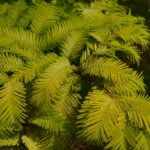
Ogon
‘Ogon (‘Gold Rush’) has bright yellow needles, the color retained in the north, zone 5 to 6; reduced in zone 7 to 8. For a yellow foliage tree, growth is quite rapid, with landscape maturity between 30 and 40’. A plant in the Dirr garden is potent until the dog days of July and August, when needles will photo-bleach (become whitish). If kept evenly moist, color is partially retained.
‘Urban Spire’ (PPAF) is a new broad-columnar, feathery needled selection, estimated to reach 18 to 20 ‘ high, 8 to 11’ wide .
See www.plantsnouveau.com for more information.
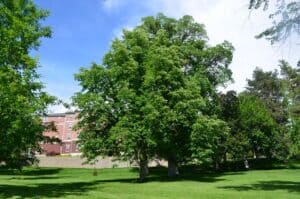
Aesculus flava at Utah State
Such a great tree, reaching its zenith in the southern Appalachians, with trees 80 to 100’ in height. Most often found in moist hardwood coves on slopes and along streams, often in the company of mountain-laurel and rhododendron. The species is also common along the Blue Ridge Parkway where it occurs at the highest elevations, ~6,000’. For unknown reasons, the tree is not common in commerce, primarily available from specialty nurseries. Compared to its European counterpart, Aesculus hippocastanum, common horsechestnut, it is significantly more disease resistant (still may contract the disease). The disease initiates brown lesions which coalesce into large brown blotches. Often visible by mid-summer and, in the case of the European horsechestnut, turns the entire tree brown.
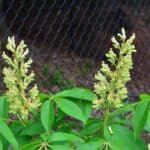
The emerging foliage ranges from green, deep bronze to maroon, maturing dark green. Leaves appear early, usually by late March-early April in zone 8. Leaves are large, composed of 5(7) obovate, finely serrated leaflets, each 4 to 6” long. In autumn, leaves develop the most beautiful pumpkin-orange color. The inflorescences develop with the foliage, opening yellow-green, are borne upright, and average 6 to 8” in length, 2 to 3” wide. Flower effect is somewhat diminished as the yellow-green blends with and is lost among the maturing leaves.
Fruits are pear-shaped, 2 to 3” long smooth brown capsules containing 1 or 2 shiny dark brown seeds. I have grown many seedlings by collecting the seeds when the outer leathery covering splits, and the brown seeds are visible. Sow immediately into well drained medium in containers or seed beds and protect from pesky squirrels (critters). The carrot-like root develops soon after sowing; the shoot emerges the following spring.
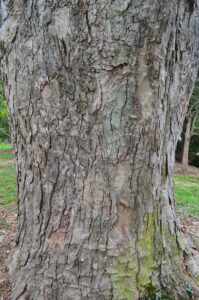
Aesculus flava bark
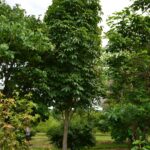
Young trees are slightly pyramidal to rounded; higher than wide at maturity, with coarse-textured branches. The bark is gray-brown, smooth initially, later developing large flat plates and scales. The exfoliation pattern is similar to a mosaic. This is truly a noble species and I observed magnificent specimens in Spring Grove Arboretum, Cincinnati, OH; Gettysburg National Cemetery; Washington and Lee, Lexington, VA; Utah State University, Logan, UT; University of Oregon, Eugene, OR; and the garden of Coach Vince Dooley, Athens, GA. Sizable trees grow on the Iowa capitol grounds, Des Moines. The species and/or a hybrid with A. glabra, Ohio buckeye, is reported hardy in North Dakota. I estimate zone (3)4 to 8 adaptability.
In June, 2016, at the USDA ARS germplasm repository, Beltsville, MD, several friends and I spied a distinctly columnar seedling (see photo) which will have a home where space to spread is restricted. This unique form is currently being propagated and evaluated by Schmidt Nursery, Boring, OR.
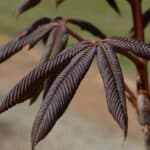
The species displays moderate heat and drought tolerance, but prefers evenly moist, well drained, acid soils, in full sun to moderate shade. The beautiful tree on the Utah State campus, where high ph is an issue, makes me think the species is well adapted to alkaline soils. In the wild it often exists as an understory plant, attesting to its shade tolerance. Seedlings are fast growing and under reasonable landscape culture expect 1 to 2’ per year in height increase. Pruning requirements are minimal. The wood appears to be strong and I have yet to witness storm-damaged trees.
Here is a species ranging from New York to Georgia west to Illinois and Mississippi that has languished in the shadow of its European cousin. For large properties, parks, campuses, corporate sites, golf courses, wherever space is abundant, the species deserves consideration. Not recommended for street tree use as fruits and leaves are messy.